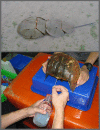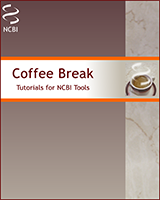NCBI Bookshelf. A service of the National Library of Medicine, National Institutes of Health.
Dean L, McEntyre J, editors. Coffee Break: Tutorials for NCBI Tools [Internet]. Bethesda (MD): National Center for Biotechnology Information (US); 1999-.
We have been using copper for almost 10,000 years. And it proved to be such a useful metal that an historical era was named after it—The Bronze Age (bronze is an alloy consisting mainly of copper) (1).
The properties of copper mean that it is still in demand today—it is an excellent conductor of heat and electricity, and is relatively resistant to corrosion. Thus, the uses of copper range from cooking (pots and pans), electronics and appliances (wiring and circuit boards), to one of the most famous statues in the world, the Statue of Liberty (2). Copper is frequently combined with other metals, such as zinc, tin, and nickel, to form alloys. The US 5 cent coin may be called a nickel, but it is only 25% nickel, the rest of the metal is copper (3).
But copper isn’t just useful; it is an essential trace mineral for most life forms. Copper is incorporated into many enzymes, such as plastocyanin, which is needed for photosynthesis in plants, algae, and cyanobacteria; and hemocyanin, which transports oxygen in species such as horse-shoed crabs and emperor scorpions, and gives them their characteristic blue-colored blood (4, 5) (Figure 1).

Figure 1: Horseshoe crabs
Top: The horseshoe crab is an ancient species that predate dinosaurs. It has a large carapace (shell) that protects its internal organs, and has ten eyes and can see UV light. Bottom: The horseshoe’s crab unique blue blood protects them, and humans, (more...)
In humans, copper is vital for the normal development and functioning of connective tissue, the nervous system, the immune system, and metabolism. For example, copper is part of cytochrome c oxidase, the last protein in the electron transport chain that is responsible for generating energy in the form of ATP (4).
Because copper is only needed in trace amounts, most people get enough copper from their diet. But rarely, inherited conditions can lead to extremely low (Menkes disease) or high (Wilson disease) levels of copper.
The importance of copper in the body means that its levels must be carefully regulated. Copper homeostasis is tightly linked to other metabolic processes. In serum, 70%-90% of copper is bound to ceruloplasmin, an enzyme that plays an important role in iron homeostasis and inflammatory response (6). Ceruloplasmin is also present in the brain, where the loss of ceruloplasmin is associated with iron accumulation and neuronal degeneration (7, 8)
To find out more about ceruloplasmin and the CP gene that encodes it, take a look at the series of “Carrying Copper” tutorials below, which explain the Entrez Gene record for CP.
Tutorial 6: General gene and protein information, NCBI Reference Sequences (RefSeq), Related sequences and Additional links
Acknowledgements
The author would like to thank Svetlana Lutsenko, PhD, Professor of Physiology, Johns Hopkins University.
References
- 1.
- Early and Middle Bronze Age. Smithsonian National Museum of Natural History [Last accessed: 16th October 2014]. Available from: http://www
.mnh.si.edu /exhibits/cyprus/early-bronze.html. - 2.
- Statue of Liberty. National Park Service [Last accessed: 16th October 2014]. Available from: http://www.nps.gov/stli/faqs.htm - aboutthestatue.
- 3.
- Coin specifications. United States Mint [Last accessed: 16th October 2014]. Available from: http://www
.usmint.gov /about_the_mint/?action =coin_specifications. - 4.
- Gupta A., Lutsenko S. Evolution of copper transporting ATPases in eukaryotic organisms. Curr Genomics. 2012;13(2):124–33. [PMC free article: PMC3308323] [PubMed: 23024604]
- 5.
- Rehm P., Pick C., Borner J., et al. The diversity and evolution of chelicerate hemocyanins. BMC Evol Biol. 2012;12:19. [PMC free article: PMC3306762] [PubMed: 22333134]
- 6.
- Hellman N.E., Gitlin J.D. Ceruloplasmin metabolism and function. Annu Rev Nutr. 2002;22:439–58. [PubMed: 12055353]
- 7.
- Miyajima, H., Aceruloplasminemia. Neuropathology, 2014. [PubMed: 25168455]
- 8.
- Vassiliev V., Harris Z.L., Zatta P. Ceruloplasmin in neurodegenerative diseases. Brain Res Brain Res Rev. 2005;49(3):633–40. [PubMed: 16269323]
- From the Statue of Liberty to the coin in your back pocket - Coffee BreakFrom the Statue of Liberty to the coin in your back pocket - Coffee Break
Your browsing activity is empty.
Activity recording is turned off.
See more...
